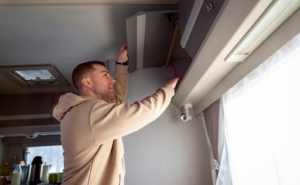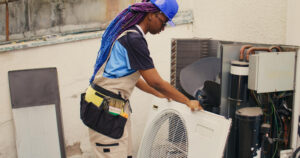Menu

The Ultimate Guide to Indoor Air Quality for a Healthier, Comfortable Home
Indoor air quality plays a crucial role in our overall health and well-being, as we spend a significant portion of our lives indoors. Poor indoor air quality can lead to various health issues, such as allergies, asthma, respiratory problems, and even chronic illnesses. At Bromac, we understand the importance of creating a healthy and comfortable indoor environment for homeowners in the Lower Mainland and Fraser Valley. Our comprehensive blog series will provide you with valuable information, practical tips, and expert insights on improving indoor air quality and enhancing the quality of life for you and your family.
We will explore factors affecting indoor air quality, common indoor air pollutants and their sources, as well as ways to reduce these harmful elements. Our blog posts will also discuss tools and techniques for measuring and monitoring indoor air quality to ensure a safe living environment. Understanding the pivotal role HVAC systems play in maintaining indoor air quality, we will delve into their impact and offer recommendations for proper maintenance and utilization.
Join us on this educational journey with Bromac as we empower you with the knowledge and tools necessary to improve indoor air quality for a healthier and more comfortable home, ensuring a safe and nurturing environment for your family. Together, let’s breathe easier and enhance our quality of life one room at a time.
Understanding the Factors Affecting Indoor Air Quality
Indoor air quality (IAQ) is influenced by various factors contributing to the presence of pollutants and allergens in the home. These factors include inadequate ventilation, humidity levels, combustion sources such as stoves and fireplaces, building materials, cleaning products, and outdoor pollutants entering through windows and doors. Being aware of these factors can help you identify and address potential issues to improve your indoor air quality.
Common Indoor Air Pollutants and How to Reduce Them
There are numerous common indoor air pollutants found in our homes, ranging from biological contaminants to chemical contaminants. Some of the most prevalent include the following:
1. Dust mites and pet dander: These allergens can cause allergy and asthma symptoms. Regular cleaning, including vacuuming and dusting, can help reduce their presence.
2. Mold and mildew: These biological contaminants thrive in damp conditions, potentially causing respiratory issues. Address the source of moisture and keep humidity levels below 60% to prevent the growth of mould and mildew.
3. Radon: A radioactive gas emitted naturally from soil and rock, radon can accumulate in homes, posing health risks. Test your home for radon and install an appropriate mitigation system if required.
4. Volatile organic compounds (VOCs): Found in many household products, VOCs can cause various health issues, including headaches and respiratory problems. Opt for low-VOC or VOC-free products and ensure proper ventilation when using these products.
5. Carbon monoxide: Toxic and odourless carbon monoxide (CO) is a byproduct of incomplete fuel combustion in appliances. Install CO detectors and have your heating system inspected annually to prevent CO buildup.
Measuring and Monitoring Indoor Air Quality: Tools and Techniques
Monitoring your indoor air quality is essential for maintaining a healthy home. Various tools and techniques can help you assess and track IAQ, including the following:
1. Air quality monitors: These devices measure temperature, humidity, VOCs, particulate matter, and other pollutants, providing you with real-time data on your indoor air quality.
2. Carbon monoxide detectors: Installing CO detectors will alert you to dangerous CO levels in your home, allowing you to take immediate action.
3. Humidity meters (hygrometers): Monitoring indoor humidity levels can help you maintain a healthy home environment, as high humidity promotes mould growth, while low humidity can cause respiratory issues.
4. Radon test kits: Available in both short-term and long-term testing options, these kits help you identify potentially dangerous radon levels in your home.
5. Professional indoor air quality assessment: Hiring a professional to assess your home’s indoor air quality can provide insights into specific issues and recommendations on how to address them.
The Role of HVAC Systems in Maintaining Indoor Air Quality
Your home’s HVAC system plays a vital role in maintaining healthy indoor air quality by circulating air, filtering pollutants, and regulating humidity levels. Properly maintaining your HVAC system can significantly improve IAQ, while poor maintenance can compromise air quality. Some best practices for maintaining your HVAC system to ensure optimal indoor air quality include the following:
1. Regularly inspect and replace air filters: Clogged or dirty air filters can cause pollutants to circulate in your home. Replace filters according to manufacturer recommendations.
2. Schedule routine maintenance: Regular professional maintenance of your HVAC system will ensure optimal performance and prevent issues related to poor indoor air quality.
3. Address issues promptly: If you observe any unusual smells, noises, or performance issues with your HVAC system, seek professional assistance to address the problem and avoid exacerbating IAQ concerns.
4. Clean and maintain air ducts: Dirty ductwork can lead to poor air quality. Have your ducts professionally cleaned and inspected at least once every three years to prevent the buildup of dust, debris, and allergens.
Conclusion
Indoor air quality plays a pivotal role in our health and well-being, making it vital for homeowners to understand the factors affecting it, as well as ways to improve it. By reducing indoor air pollutants, monitoring IAQ, and properly maintaining your HVAC system, you can create a healthier, more comfortable home for you and your family.
Embark on this proactive journey with Bromac, your trusted partner in understanding and enhancing indoor air quality and providing top-quality heating and plumbing services. Together, let’s breathe easier knowing we’re creating a more enjoyable and healthier living environment for ourselves and our loved ones. Contact us now to learn more!


